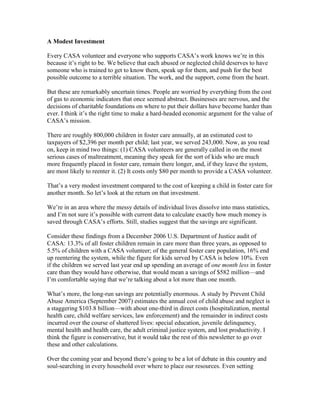
A Modest Investment in Foster Care Yields Major Savings
- 1. A Modest Investment Every CASA volunteer and everyone who supports CASA’s work knows we’re in this because it’s right to be. We believe that each abused or neglected child deserves to have someone who is trained to get to know them, speak up for them, and push for the best possible outcome to a terrible situation. The work, and the support, come from the heart. But these are remarkably uncertain times. People are worried by everything from the cost of gas to economic indicators that once seemed abstract. Businesses are nervous, and the decisions of charitable foundations on where to put their dollars have become harder than ever. I think it’s the right time to make a hard-headed economic argument for the value of CASA’s mission. There are roughly 800,000 children in foster care annually, at an estimated cost to taxpayers of $2,396 per month per child; last year, we served 243,000. Now, as you read on, keep in mind two things: (1) CASA volunteers are generally called in on the most serious cases of maltreatment, meaning they speak for the sort of kids who are much more frequently placed in foster care, remain there longer, and, if they leave the system, are most likely to reenter it. (2) It costs only $80 per month to provide a CASA volunteer. That’s a very modest investment compared to the cost of keeping a child in foster care for another month. So let’s look at the return on that investment. We’re in an area where the messy details of individual lives dissolve into mass statistics, and I’m not sure it’s possible with current data to calculate exactly how much money is saved through CASA’s efforts. Still, studies suggest that the savings are significant. Consider these findings from a December 2006 U.S. Department of Justice audit of CASA: 13.3% of all foster children remain in care more than three years, as opposed to 5.5% of children with a CASA volunteer; of the general foster care population, 16% end up reentering the system, while the figure for kids served by CASA is below 10%. Even if the children we served last year end up spending an average of one month less in foster care than they would have otherwise, that would mean a savings of $582 million—and I’m comfortable saying that we’re talking about a lot more than one month. What’s more, the long-run savings are potentially enormous. A study by Prevent Child Abuse America (September 2007) estimates the annual cost of child abuse and neglect is a staggering $103.8 billion—with about one-third in direct costs (hospitalization, mental health care, child welfare services, law enforcement) and the remainder in indirect costs incurred over the course of shattered lives: special education, juvenile delinquency, mental health and health care, the adult criminal justice system, and lost productivity. I think the figure is conservative, but it would take the rest of this newsletter to go over these and other calculations. Over the coming year and beyond there’s going to be a lot of debate in this country and soul-searching in every household over where to place our resources. Even setting
- 2. aside—for the moment—all the reasons of the heart, there’s a compelling case to be made that investing in these children (and supporting CASA) is the sort of sound economic policy that we should all be able to agree on.